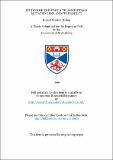Files in this item
Studies of the ataxia telangiectasia mutated gene and its product
Item metadata
| dc.contributor.advisor | Steel, Michael | |
| dc.contributor.author | Hislop, Robert Gordon | |
| dc.coverage.spatial | 142 p. | en_US |
| dc.date.accessioned | 2018-06-11T14:09:49Z | |
| dc.date.available | 2018-06-11T14:09:49Z | |
| dc.date.issued | 1999 | |
| dc.identifier.uri | https://hdl.handle.net/10023/13908 | |
| dc.description.abstract | ATM is a large and complex gene, identified as the recessive gene mutated in individuals with the childhood syndrome ataxia telangiectasia. While AT patients are rare and the disease has many severe symptoms, including cerebellar degeneration, immunodeficiency and a very high cancer risk, the relatively common carriers of one mutation are clinically normal. However, there is some evidence that these heterozygotes, too, have a high relative risk of cancer, especially breast cancer in women. The cellular radio sensitivity of carriers is intermediate between that of normal individuals and that of AT patients, and this may suggest the cells are predisposed to tumorigenic transformation. ATM is believed to be involved in DNA damage response, but the mechanisms by which it works are not fully understood. In this study, DNA from 412 Scottish women with breast cancers were screened for two ATM mutations, known to be relatively common in Celtic populations. In attempting to estimate the burden in Scotland of breast cancers in AT heterozygotes, it is shown here that even these two most common ATM mutations in the UK account for only a small proportion of all ATM mutations. None of these mutations were found, suggesting that these particular mutations do not confer a predisposition to breast cancer. Also presented are the results of various immunological studies. The ATM protein is shown to be localised to specific structures within the nucleus of a normal cell. It appears to be found in a number of different forms, varying in size and state of glycosylation. It sediments at a relatively low speed, suggesting that it is normally bound in a large protein complex. This work indicates that a large-scale screening study will be required to establish whether or not AT carriers are at an increased risk of cancer, and reveals that the ATM product may be present in more than one form, depending on whether the cell' stimulated to divide. | en_US |
| dc.language.iso | en | en_US |
| dc.publisher | University of St Andrews | |
| dc.subject.lcc | QH465.H5 | en |
| dc.subject.lcsh | DNA damage | en |
| dc.title | Studies of the ataxia telangiectasia mutated gene and its product | en_US |
| dc.type | Thesis | en_US |
| dc.type.qualificationlevel | Doctoral | en_US |
| dc.type.qualificationname | PhD Doctor of Philosophy | en_US |
| dc.publisher.institution | The University of St Andrews | en_US |
This item appears in the following Collection(s)
Items in the St Andrews Research Repository are protected by copyright, with all rights reserved, unless otherwise indicated.

